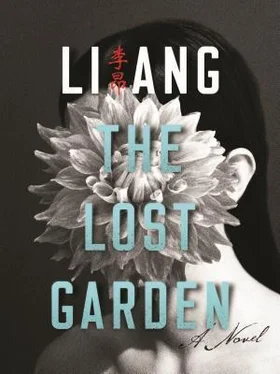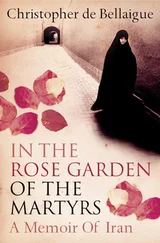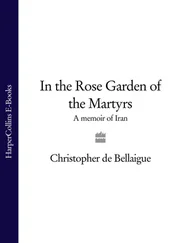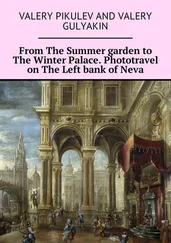“Now all I can do is use this device from an advanced country to take pictures of useless objects. There’s nothing for me to do. I’m useless too.”
Father enjoyed repeating stories of his life overseas, particularly focusing on cameras and photography, to the point that Yinghong could recite them from memory. But she still loved to hear him talk, for this marked the rare moments when his sad eyes glowed with vitality, even if it was short-lived.
After reading the books purchased from Japan, Father began to pay attention to the grid-of-gold structure, that is, making a grid with nine squares, like the one for a game of tic-tac-toe, placing what he wanted to shoot on the four points where the lines met. By using the grid, he took some well-formed pictures of scenes in Lotus Garden laden with trees and flowers.
In the black-and-white images, the pavilions, the towers, and the terraces were overshadowed by layers of green from the trees, and appeared to be cowering, usually with only the corner of a building, a few stone pillars, and some doors and windows left to struggle to break away from the verdant burial ground. It seemed to presage a not-distant future when everything would deteriorate until nothing was left; the structures and everything else would be gone, tragically swallowed up.
In addition to his Leica III, Father asked a friend to buy a Leica M3, a new model, for him. It came with three lenses, 50mm, 90mm, and 135mm.
Father waited in the garden daily from dawn to dusk with his two cameras and a set of lenses. As additional photos were developed, he grew more demanding of the quality. He tried to find the best balance between dark and light, which meant he’d spend a great deal of time waiting for the sun to move, for the weather to change, or for shadows to appear.
In terms of composition, he gradually broke away from the rigid grid; instead, he now formed a rectangle with his thumbs and index fingers and moved it nearer or farther away from him as he walked around to gauge the composition and arrangements of objects.
When Yinghong finished her homework after school, she would, with his permission, follow him around Lotus Garden, where she too formed rectangles with her fingers to observe the scenes around her.
On days when Father would not let her stick around she roamed the garden by herself. One evening in late spring, when she was in the fifth grade, she went to the Plucking Green Pavilion in the northeast corner of the compound. The pavilion was adjacent to a large grove of dense bamboo that had not been cut for a long time. Each bamboo plant was as thick around as a rice bowl. She saw an emerald-green snake, shorter than the length of her open palm. Pure green, it sparkled in the bright sunlight, but turned a deep, dark green in the shades, slithering in and out of the fallen bamboo leaves on the ground, visible one moment and out of sight the next. Captivated by the beautiful snake, she formed a rectangle with her hands and moved them around, trying to see it better. But before she had a chance, the snake vanished from her sight and was nowhere to be seen again.
It was such a pity that she babbled about the snake to Father at the dinner table, only to be shocked by his blanched face.
“Don’t go to Plucking Green Pavilion again, or I’ll give you a good spanking.”
She froze from his loud voice and the unprecedented threat, tears welling up in her large eyes. Father then took her hand and changed to a gentle soothing tone:
“It’s a poisonous ‘green bamboo silk’ snake. If it bites you you’ll die on the spot.” He paused and, as if to make sure she understood the severity of his warning, looked hard at her as he went on, “Do you know what death is?”
She nodded, holding back her tears.
“I know. Mudan told me that death means you can’t see anything any more. Death means not being able to see Otosan, Okasan, and—”
She stopped and finished her sentence quickly:
“—and not being able to see Lotus Garden.”
Father looked at her with loving tenderness as he continued:
“There’s another poisonous snake in Taiwan called the ‘hundred steps.’ Why is it called that? Because once you’re bitten, you’ll die after taking a hundred steps. Green bamboo silk is even more venomous than hundred steps, for you’ll die before taking a hundred steps.”
She listened carefully and shuddered at the thought that a beautiful, emerald-green snake could be so lethal. Then all of a sudden, tears began streaming down her face and she burst into sobs, as another concern occurred to her.
On a warm late-spring evening, the fifth-grader, Yinghong, was struck by the thought that she need not worry if she were bitten by a green bamboo silk snake; as long as she stood still, she wouldn’t die. Didn’t Otosan say that she’d die after taking a hundred steps? So she wouldn’t take a single step; instead she’d simply stand there, waiting for Otosan to save her.
She raised her hand to rub her eyes and dry her tears.
When she was a little older and had graduated from elementary school, Father’s renovation of the Lotus Garden reached Plucking Green Pavilion, where most of the bamboo was cut down. Father made clear soup out of the small shoots that had just poked through the ground. When there was no more threat of the green bamboo silk snake, she brought it up with Father that even back then, she’d not been afraid of the snakes, for she had an effective solution of not moving if she were bitten. She wouldn’t take a single step, let alone a hundred, which would spare her life.
Father burst out laughing uncharacteristically, lending his gaunt face a false image of fullness and adding vitality to his large, dark eyes.
“Ayako,” Father spoke in Japanese, as usual. “When I said a hundred steps, I didn’t mean the actually number of steps. I was talking about the time it takes to walk one hundred steps.”
She was so shocked she broke into a cold sweat.
“Let’s try to see how long it will take to walk a hundred steps.”
Walking ahead of her, Father started from Plucking Green Pavilion and reached the little bridge by Moon Descending and Wind Arriving, where he stopped to look at his watch, and then continued to count:
“Ninety-seven, ninety-eight, ninety-nine, a hundred. Slightly over a minute.”
Yinghong couldn’t stifle a startled cry.
Shortly after she had spotted the green snake by Plucking Green Pavilion, Father’s days of taking photographs stretched into months. When he’d finished photographing all the scenery in Lotus Garden, he was at a loss as to what to do next. It so happened that a hundred-year-old plane tree, with its many twisted branches laden with twigs and leaves, fell and crashed down on the soaring eaves on one side of Lotus Tower, giving Father the idea of beginning a large-scale renovation of Lotus Garden.
Removing withering plants that were meant for cold weather, he replaced them with flowers and trees indigenous to Taiwan, while the masons repaired the fences, roofs, and brick walls that were loosened or damaged by the roots of various plants. Father took detailed pictures of the renovation process.
Many years later, after marrying Lin Xigeng and deciding to renovate Lotus Garden again, she dug out the thousands of pictures Father had taken. She saw that his camera lens had captured the minute details of how the wood joints were connected and the roof tiles were laid down.
He had even made adjustments to Lotus Garden’s structures to accommodate his photography work. Authenticity Studio had been the book storage and reading room in Lotus Garden, which was why it had windows high enough to take up nearly two-thirds of the wall, with pane after pane of glass on the four walls. Even the tall doors were made of carved frames fitted with glass panes, flooding the room with bright light. The latticed windows were decorated with the usual auspicious pictures and patterns, but the four corners had elaborate, exquisite wood carving and inlay to showcase the four botanic gentlemen — plum, orchid, bamboo, and chrysanthemum. The branches on the plum were resilient and robust, while the orchid leaves were lively and elegant, all giving the unique flair of an upright gentleman.
Читать дальше












